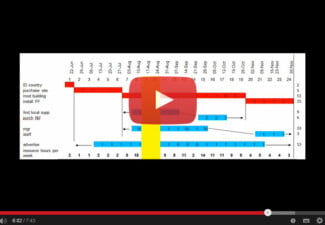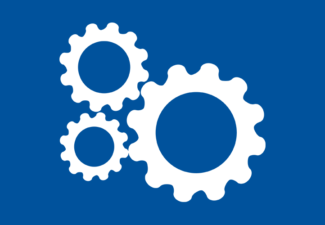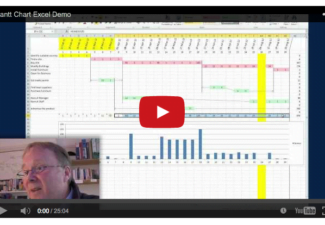I think the biggest secret of project management is that you need BOTH a critical path diagram AND a Gantt chart.
Here’s why:
If you only have a critical path diagram:

Then it’s great, you know the running order, and you know how long the project is going to take – from the critical path, the red line in the example above, which shows the longest path and therefore the slowest path through the project.
But you don’t know the dates of when each task will be happening, and it’s not drawn to scale – the boxes that take 1 week are the same size as the boxes that take 10 weeks. So you can’t see if anything collides with Christmas or your summer holidays, or any significant business dates in your calendar. You also can’t see the overlap which tells you which tasks are happening at the same time as others, which then allows you to think about whether you have enough people to do everything you want to do.
For all this you need a Gantt chart:

The Gantt chart does all of the above, and more, for example you can colour in what you’ve done so far, and see whether you’re keeping up with your plan, and you can allocate tasks to people, and you can add up the time and money for each task and each week. Having a Gantt chart for a project is a no brainer!
So why bother with the Critical Path diagram (aka network diagram or PERT chart)? Why not just have the Gantt? … and this is exactly what many people do, they just go straight to the Gantt chart.
BUT – if you do that, it will take you much longer to produce your Gantt chart, and it will be WRONG! Unless your project is very linear (almost no tasks in parallel) you wont be able to jump straight to the Gantt chart, because in order to draw it you have to know what the critical path is. And only the network diagram tells you that – you have to draw that first in order to find out the critical path, and then all the other tasks hang off that.
See the example above, showing the red path, the longest/slowest path? We found that by drawing the network diagram. Who knew it would go through installing the furniture and no through recruiting the staff? So it took 20 minutes to make that diagram, and then 10 more minutes to make the Gantt chart based on it.
To make the Gantt chart from scratch would have taken an hour, and would still have been wrong. Have a look at my Gantt above – could YOU have drawn it, without having thew critical path already given to you?
So the critical path diagram is a vital step along the way. Once you have the Gantt chart you can discard the critical path diagram, you never try to jump straight to your Gantt chart!
Want to know more – get me in to do some Zoom training, or check out my online courses on udemy.com or linkedin learning.





